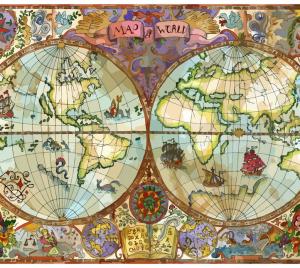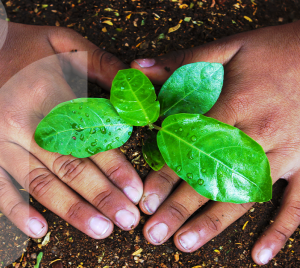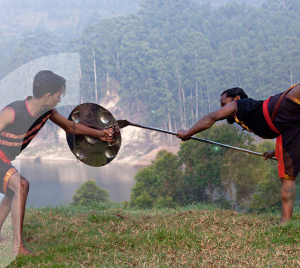
The Indus Valley civilization, one of the world's oldest, flourished during the 3rd and 2nd millennia B.C. and extended into northwestern India. Aryan tribes from the northwest infiltrated the Indian subcontinent about 1500 B.C.; their merger with the earlier Dravidian inhabitants created the classical Indian culture. By the 19th century, Great Britain had become the dominant political power on the subcontinent. The British Indian Army played a vital role in both World Wars. Years of nonviolent resistance to British rule, led by Mohandas GANDHI and Jawaharlal NEHRU, eventually resulted in Indian independence, which was granted in 1947. Large-scale communal violence took place before and after the subcontinent partition into two separate states - India and Pakistan. The neighboring nations have fought three wars since independence, the last of which was in 1971 and resulted in East Pakistan becoming the separate nation of Bangladesh.
Fascinating Facts
- Kalaripayattu, also known as Kalari, is believed to be the oldest surviving martial art form in India and is among the oldest known in the world, dating back to the 3rd century BCE.
- While Hindi and English are the most common languages, India does not recognize a national language, and there are 22 languages that are recognized by the Indian constitution as “official:” Bengali, Hindi, Maithili, Nepalese, Sanskrit, Tamil, Urdu, Assamese, Dogri, Kannada, Gujarati, Bodo, Manipur (or Meitei), Oriya, Marathi, Santali, Telugu, Punjabi, Sindhi, Malayalam, Konkani, and Kashmiri).
- Cows cannot be harmed in India and won’t be bothered, even when they walk around in the cities and cause traffic jams.
- During the fourth century, the astronomer Aryabhatta determined that the Earth revolves around the sun. This was not accepted as fact in the Western world until many centuries later when Copernicus came out with his theory.
Religion and Ethnic Groups
- Indo-Aryan 72%, Dravidian 25%, Mongoloid and other 3%
- Hindu 79.8%, Muslim 14.2%, Christian 2.3%, Sikh 1.7%, other and unspecified 2%
Greetings
- Common greetings include saying “Namaste,” placing both hands together, and bowing, or two men may shake hands. Men usually do not shake hands with women and should wait to see if the woman extends her hand before doing so.
- Addressing an older man or woman as “sir” or “ma’am” is a safe bet. Naming conventions vary widely because of the cultural and religious diversity in the country. If you are unsure of how to address someone, it’s best to ask what they prefer.
- Because India is a hierarchical society, elders and people with a higher social standing should be greeted first. Caste/social standing and religion all play a part in how and when someone is greeted.
- Waving at someone (moving hand from side to side) may be interpreted as saying “no” or “go away.” Do not use this as a way of greeting someone.
- Close male friends may pat each other on the back.
General Social Etiquette
- India has a patriarchal society, so women will follow and obey their fathers, husbands, and sons.
- Due to the complexities of social interactions between others, it is best to observe how people are interacting and to follow their lead.
- Only use your right hand when touching something or accepting/giving an item.
- Don’t stand too close to others. Leaving about an arm’s length of space is usually sufficient.
- Gestures and hand/head movements in the Western world may be different in India. For example, you shouldn’t snap your fingers or use your hand to call someone over. Instead, extend your arm and move your fingers in a downward direction (like a claw). Pointing (one or two fingers) is also considered rude. So, people will use their chin, thumbs, and entire hands instead. Instead of nodding, people may move their head back or in a figure eight motion to indicate “yes” or agreement.
- Touching someone on the head and affectionate physical touch in public is discouraged.
- The feet and left hands are considered “unclean,” so avoid touching these body parts on other people. Ears are also considered sacred and should not be touched.
- Do not show anger, whistle, or wink.
- Gifts are not given until a relationship is established with someone.
- When exchanging gifts, they should be presented using both hands (never just the left hand). Expect that the gift will not be opened while you’re there.
- Avoid wrapping gifts in black or white paper or giving gifts that are all black or all white. The color black represents evil, anger, and negativity, and white is typically used during funerals and times of mourning.
- When entering someone’s home, you will usually be expected to remove your shoes. Watch what the host does.
- Punctuality is usually only a concern for formal and business meetings. It is acceptable to arrive 30 minutes to an hour late for social gatherings.
Eating
- You should always accept a dinner invitation, unless you have a conflict or a specific reason for not attending.
- Alcohol is not consumed if the person is a strict Muslim or a Hindu woman. Pork and beef are also not consumed, based on the religious practices of the individual.
- Many dishes are eaten with your hands, so expect to be asked to wash your hands before eating. Never eat with your left hand.
- Serving food is done in a particular order, based on hierarchy. The guest of honor is first. Men are second and children are third. Women will usually eat later.
- You should accept all the food your host serves. However, it won’t be considered rude if you do not finish everything on your plate.
- You can serve yourself, if it is a communal dish, but you should always do so with a spoon.
- If you’re eating at a restaurant, the person who extended the dinner invitation will usually pay. If you’ve been invited for dinner, you should then in turn invite the host to dinner at a later date.
Getting around
Bicycles are a very popular mode of transportation in India. It’s not uncommon for people to just use a bicycle within a city and also for long-distance travel. Bicycles can be taken on buses and trains, if needed.
Taxis and rickshaws are available in cities. Be aware that taxi drivers may try to not use the meter for the fare. If the driver does not use the meter, be sure to negotiate the rate before the trip. Delhi and Kolkata also have metro systems available.
Car rentals are available. However, many agencies include a driver with the car. It’s also possible to rent a car or motorbike to drive yourself. When driving, be aware that rural roads may be in disrepair, and can be blocked by animals and people driving slow-moving carts.
In cities, traffic can be unpredictable, and traffic rules are not usually followed. Pedestrians, cyclists, and animals may wander into the road without warning, so avoid driving at night.
Buses are available travel within and between cities. Bus routes are extensive and cover most locations. The quality of the bus in terms of comfort will vary, depending on whether you’re traveling on a government-run bus or a private bus. Keep in mind that not all private bus lines are completely legal, and those that are not may have more issues in the event of a bus breakdown. City buses can be very crowded, and theft is common.
Traveling by train is another good option, especially for long distances. However, expect that your train will be late, even hours late.
Key phrases (Hindi)
Welcome: Svāgat
Hello/good morning/good evening/goodnight/goodbye: Namaste
Sorry: Maaf kijiye
Thank you: Dhanyavad
Excuse me: Suniye
Please: Kripayaa
What’s your name?: Aapka naam kya hai?
My name is…: Mera naam [your name] hai
Do you speak English?: Kyā āp aṅgrēzī bolte haiṅ?
Please speak more slowly: Kṛipayā zarā dhīre boliye
I don’t understand: Maiṁ samajhā nahīṅ
Where is the bathroom?: Shauchalay kahan hai?
How are you?: Aap kaise hain?
I’m fine. You?: Main theek hoon. Tum?
Featured Resources


Here in the US, we celebrate trees annually with Arbor Day.

India has a vibrant and diverse culture, and its sports heritage is no
All Resources
India has a vibrant and diverse culture, and its sports heritage is no different. A variety of…
 CultureReady
CultureReady